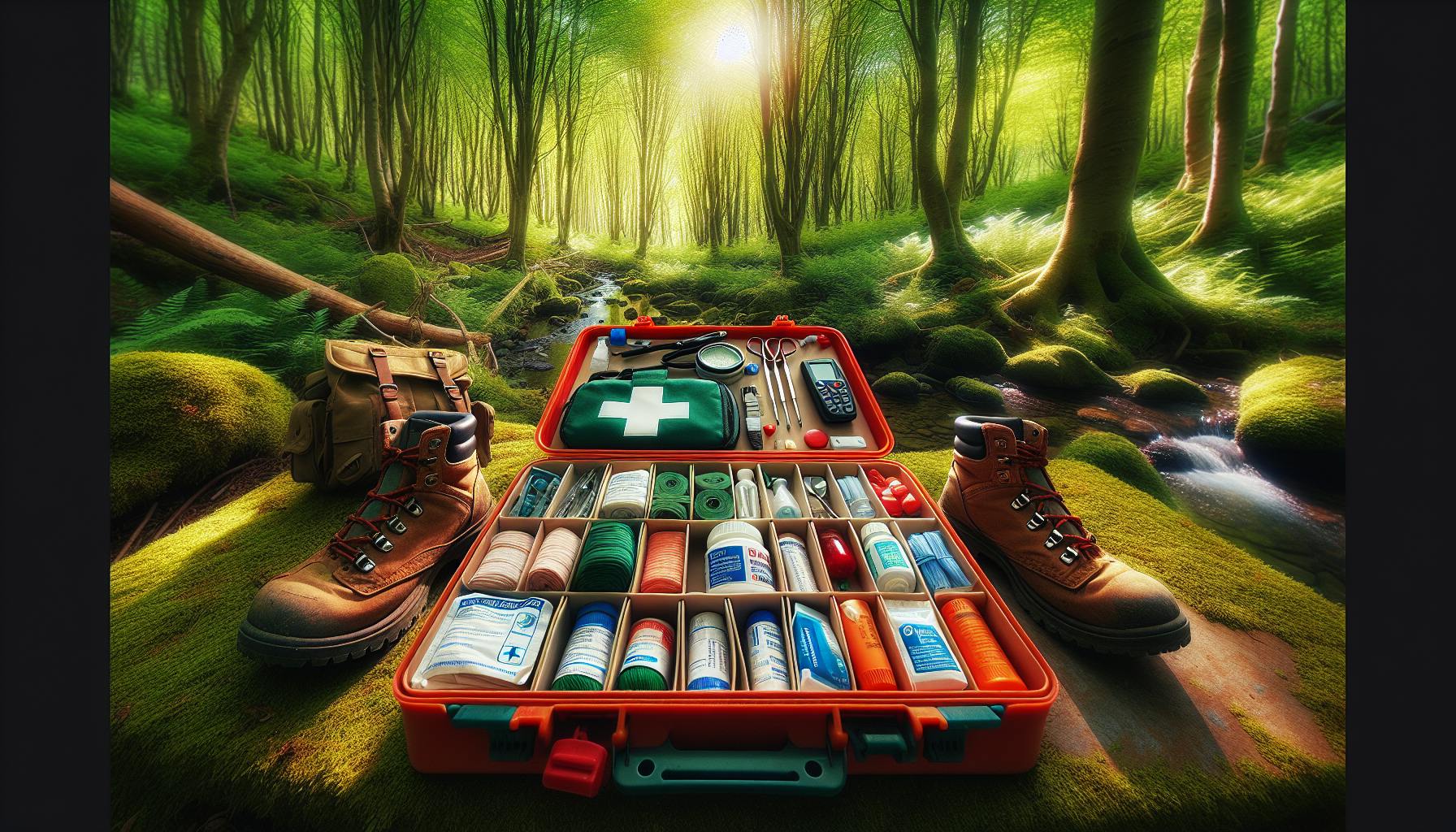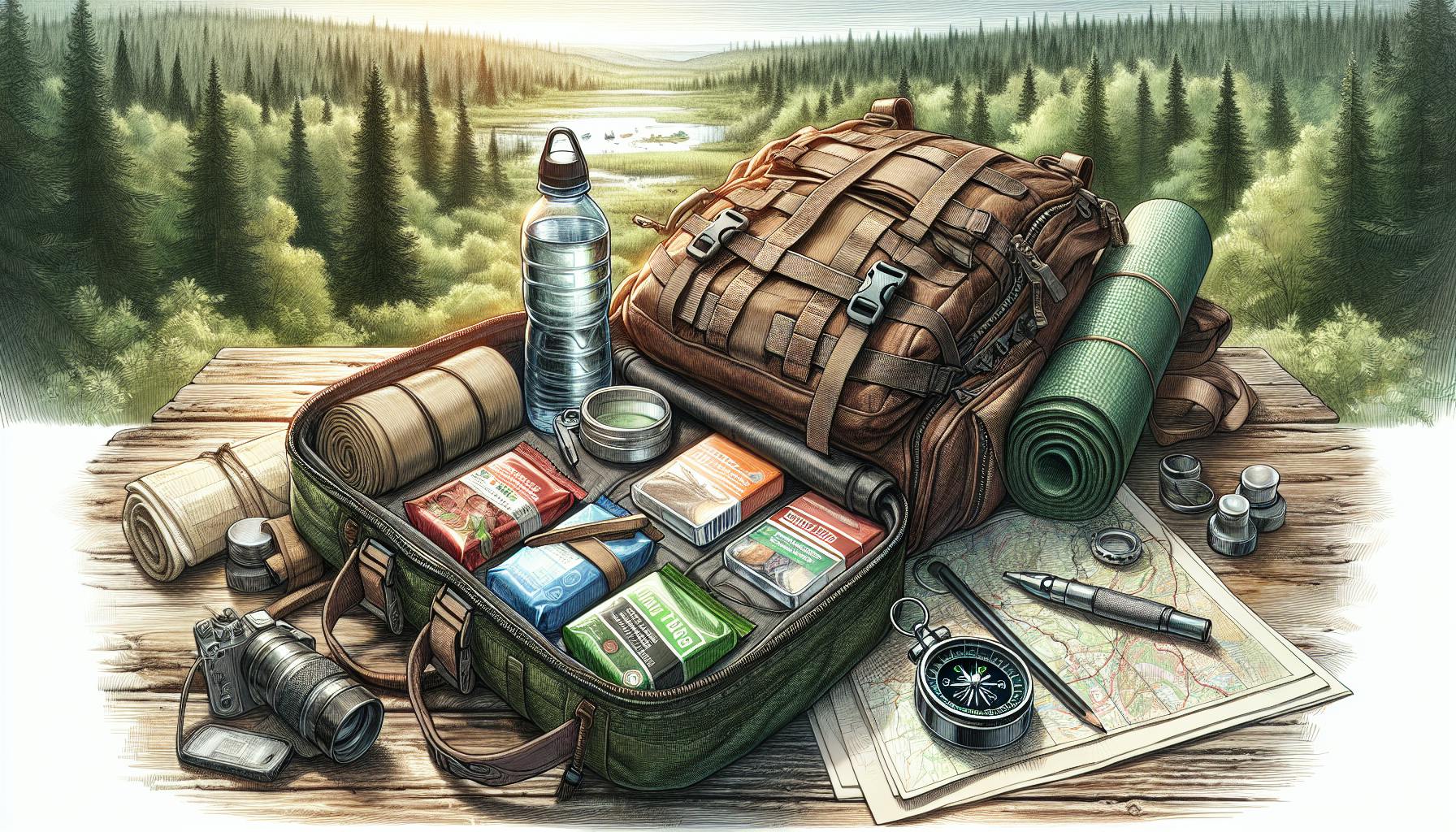When preparing for emergencies, we all understand the importance of having survival food on hand.
By choosing the right bucket of survival food for your needs, you can ensure you and your family are nourished in times of crisis.
In this article, we'll compare popular options for pre-made and DIY survival food buckets based on shelf life, nutrition, taste and more. You'll learn key factors to consider when selecting an emergency food supply so you can confidently prepare for the future.
Introduction to Choosing Your Bucket of Survival Food
Having a well-stocked bucket of survival food is crucial to be prepared for emergencies like natural disasters or power outages. When selecting an emergency food supply, key factors to consider include nutritional value, shelf life, taste, variety, and cost.
The Importance of Emergency Food Preparedness
It's vital for households to have survival food buckets in case of emergencies for a few key reasons:
- Power outages - Even short power outages can leave you without access to refrigerated or frozen foods. Having non-perishable food on hand ensures you have something to eat.
- Natural disasters - From earthquakes to hurricanes, emergency events can destroy food supplies and leave you stranded without access to grocery stores. Survival buckets mean you'll have food to rely on.
- Civil unrest - Social upheaval events like protests or riots can temporarily cut off access to normal food distribution channels. Emergency food buckets help bridge gaps in the food supply chain.
Having at least a 3-day supply of food packed and ready provides comfort and safety for your family in unstable conditions. Assembling an emergency food kit should be part of every household's preparedness strategy.
Key Factors When Choosing the Best Bucket of Survival Food
When comparing emergency food buckets, here are the most vital factors to evaluate:
- Nutritional value - Seek buckets with meals providing complete proteins, complex carbs, fruits/veggies for vitamins. Avoid relying solely on sugary snacks.
- Shelf life - Some buckets last 5+ years, while others are only good for 12 months. Consider your ability to rotate supplies.
- Taste - Sample kits first when possible. See if your family finds the meals palatable, especially for longer-term reliance.
- Variety - Rotating different entrees and sides prevents taste fatigue. Seek options with breakfasts, lunches, dinners.
- Cost - Buckets range from $50 to $300+. Compare number of servings/calories per dollar to maximize value.
Choosing buckets that align across all five factors results in the best supply to meet your household's unique emergency needs.
What foods should I stockpile for survival?
When building your emergency food supply, focus on nutrient-dense non-perishable foods with a long shelf life. Here are some of the best options to include:
Canned and Dried Proteins
Stock up on canned varieties of meat, beans, fish, and poultry. These are packed with protein to help maintain strength and energy. Prioritize lean options like chicken, salmon, tuna, turkey, and beans over fatty meats.
Whole Grains
Whole grains like oats, barley, quinoa, brown rice, and pasta provide essential carbs. Opt for whole grain versions over refined white grains for more nutrition. Make sure to store grains in airtight containers to maximize freshness.
Canned Fruits and Vegetables
Keep a variety of canned veggies and fruits, which will provide key vitamins and minerals. Go for lower sodium options when possible. Canned pumpkin, sweet potatoes, and tomato products also store well.
Shelf-Stable Dairy
Powdered milk, canned evaporated milk, and nut-based milks like almond and coconut milk can help meet calcium needs. Hard cheeses also have a decent shelf life.
Comfort Foods
Don't forget about morale-boosting foods like chocolate, coffee, tea, honey, maple syrup, and crackers. These provide mental health benefits in stressful situations.
Focus on nutrition density, shelf life, variety, and personal preferences when stocking up on survival foods. Store items properly and rotate as needed.
What are the top 10 survival foods?
When building your emergency food supply, focusing on nutrient-dense non-perishable foods is key for survival. Here are the top 10 survival foods to stock up on:
- Whole grains like brown rice, oats, quinoa, and whole wheat flour are packed with fiber, protein, and nutrients. They have a long shelf-life and provide steady energy.
- Canned goods like beans, vegetables, fruits, soups, and meats are convenient and last 2-5 years unopened. Choose low-sodium options.
- Nuts and seeds are calorie-dense, high in protein and healthy fats. Stash almonds, walnuts, sunflower and pumpkin seeds.
- Dried beans and lentils are an economical protein source with a shelf life of up to 30 years. They are versatile and nutrient-rich.
- Canned or dried vegetables and fruits provide essential vitamins and minerals. Stock up on spinach, carrots, sweet potatoes, beets, pineapple, apples, etc.
- Shelf-stable dairy like powdered milk and shelf-stable UHT milk boxes help meet calcium needs. They last 6-12 months sealed.
- Canned meats like tuna, salmon, chicken, and beef are protein-packed. Choose options packed in water over oil.
- Honey is antibacterial and antimicrobial. It keeps practically forever unopened.
- Salt is essential for health. Store iodized table salt or sea salt.
- Oils like olive, coconut, and vegetable oil store well long-term. Oils are calorically dense and multi-purpose.
Focus on nutrition, shelf-life, and multi-purpose ingredients when stocking up on survival foods. Build a diverse emergency food supply covering all nutritional bases.
What is the best non perishable food for emergency?
When building an emergency food supply, it's important to focus on shelf-stable foods that don't require refrigeration. Some good options to consider include:
Canned and Boxed Goods
- Canned fruits, vegetables, beans, soups, meats, and seafood can last 2-5 years unopened. Look for low or reduced sodium options.
- Boxed milk, juices, broths, and grains like rice, quinoa, pasta, and oats, can last 6-12 months unopened.
Snacks and Comfort Foods
- Crackers, peanut butter, jelly, nuts, trail mixes, and dried fruits make handy high-calorie snacks.
- Granola bars, protein bars, and hard candy offer quick energy boosts.
- Instant coffee, tea bags, hot chocolate mix, and electrolyte drink mixes can lift spirits.
Ready-to-Eat Meals
- MREs (Meals Ready to Eat) are convenient, shelf-stable meals requiring no preparation beyond heating.
- Freeze-dried and dehydrated meal pouches from brands like Mountain House offer better taste with simple rehydration.
Focus on nutrient-dense foods with long shelf lives, and avoid products with hydrogenated oils, high fructose corn syrup, and excessive sodium. Rotate stock every 6-12 months, and store in a cool, dark place to maximize freshness. With some planning, you can build tasty emergency food reserves.
sbb-itb-b932644
Why is Costco selling emergency food kits?
Costco's decision to sell emergency food kits aligns with their goal of providing quality products at a good value to their members. As the section context mentions, the Nutristore kits offer families an affordable way to prepare for potential disasters or emergencies.
While the Nutristore kits may be on the lower end of Costco's food storage offerings, they still provide the essential components - food, water, first aid - to handle crisis situations. For families new to emergency preparedness, these starter kits can educate on key supplies needed without a huge upfront investment. Even more prepared households may appreciate having basic provisions to hand out to neighbors or donate if a community crisis occurs.
Ultimately, Costco aims to anticipate and meet their members' needs. With natural disasters on the rise, interest in emergency preparedness continues growing across North America. Costco's food kits represent a logical extension into this market. The ability to order online and have bulk quantities shipped directly to your door makes building up food storage more convenient.
For many families, Costco's brand name and bulk buying model offers confidence in the quality and value of emergency supplies. Rather than feel overwhelmed trying to source individual components, the kits simplify crisis readiness for households at all levels. As major weather events and potential supply chain disruptions loom, expect even more big box retailers to expand their survival food product lines.
Assessing the Best Survival Food Companies of 2023
When building an emergency food supply, it's important to choose high-quality products from reputable companies. As you research options, consider shelf life, calories/nutrients per serving, taste, and value. Here is an overview of some top-rated survival food brands to help guide your decision.
Mountain House Meals in a Bucket
Mountain House earns rave reviews for their tasty, nutritious bucket meals designed to last 30 years when stored properly. Their cooking process locks in flavor and nutrients better than freeze drying alone. Menu options range from classic comfort foods to globally-inspired dishes made with quality ingredients. This makes Mountain House a go-to for delicious emergency meals.
The ReadyWise Emergency Food Supply Advantage
For an extremely affordable survival food supply, ReadyWise is a great choice. Their food buckets offer reliable nutrition and a 25-year shelf life. According to some customer reviews, the taste is not on par with higher-end brands. But ReadyWise's low cost per meal makes this a balanced, budget-friendly option.
Augason Farms: A Blend of Variety and Shelf Stability
Augason Farms offers a diverse range of emergency food buckets designed to last up to 25 years. They focus on providing great-tasting meals using quality ingredients. With breakfasts, entrées, vegetables, and desserts, their variety helps add interest to a long-term food supply. Their all-in-one kits also simplify emergency planning.
The Reliability of Legacy Food Storage Solutions
Legacy Food Storage pledges their non-GMO ingredients will nourish families for up to 25 years. Their emergency food buckets earn positive reviews for good taste, especially considering their long shelf life. Legacy also offers bulk ingredients like freeze-dried vegetables to customize kits. For a reliable well-rounded food supply, Legacy is a safe bet.
When selecting an emergency food bucket, weigh priorities like shelf life, taste, nutrition, variety, and affordability. Comparing top-rated brands can help identify the best solution for your family’s needs and budget. Proper storage will ensure your food supply stands the test of time when you need it most.
Creating a DIY Survival Food Bucket
Assembling your own custom survival food bucket allows you to tailor the ingredients to your dietary needs and preferences.
Selecting a Food-Grade Bucket for Your Emergency Food Supply
When creating a DIY survival food bucket, start by choosing a high-quality food-grade plastic pail with a tight-fitting lid to store your dried goods. 5-7 gallon buckets work well. Be sure to also get Mylar bags, oxygen absorbers, and desiccants to protect the food from oxygen, moisture, insects, and rodents. Some recommended suppliers for DIY food grade bucket components include Augason Farms, ReadyWise, and Emergency Essentials.
Achieving Nutritional Balance with Mix-and-Match Foods
The benefit of a DIY survival food bucket is that you can hand-pick ingredients to meet your nutritional needs. Be sure to include a balanced mix of proteins, grains, fruits, vegetables, and healthy fats. Tailor the combination of freeze-dried, dehydrated, or other preserved foods to align with any dietary restrictions you may have. A diverse mix of ingredients also helps mitigate taste fatigue if relying on your food supply for an extended time.
Incorporating Home-Prepared Meals and Snacks
You can include home-cooked and packaged foods like granola bars, trail mix, or jerky to add variety and familiarity to your survival food bucket. Be sure to prep and store any homemade additions properly in Mylar bags with oxygen absorbers to prevent spoilage. This allows you to customize your emergency food supply with family favorites.
Maintaining Food Safety and Longevity
To ensure your DIY bucket ingredients remain safe to eat and retain nutrients, store in a cool, dark, and dry location. Use airtight, food-grade packaging materials to limit oxygen and moisture exposure. Incorporate desiccants to absorb humidity, and refresh oxygen absorbers every 6-12 months. Properly stored foods can remain viable in your DIY survival bucket for years. Rotate and replace ingredients before expiration dates for maximum freshness and nutritional value.
Evaluating Pre-Made Survival Food Kits
Pre-made survival food kits offer convenience and tailored solutions for emergency preparedness. However, custom food buckets allow for more personalization. By understanding the pros and cons of both approaches, you can make an informed decision for your family's needs.
The Convenience of Ready-to-Eat Meals
Ready-to-eat meals in survival kits mean not having to worry about cooking or preparation during an emergency. Products like freeze-dried entrees, MREs, or meal replacement bars allow for quick, nutritious meals on-the-go. Consider kits with heaters or just-add-water meals for true convenience.
However, ready-to-eat meals often come at a higher cost per calorie. And variety can be limited compared to bulk ingredients.
Specialty Kits for Dietary Restrictions
Many pre-made kits accommodate common diets like gluten-free, vegetarian/vegan, or allergen-free. This removes the guesswork of finding compatible ingredients yourself.
Check company certifications and labeling to verify specialty claims. Also note that restrictions can limit variety. Weigh your specific needs vs. food fatigue over long emergencies.
Cost vs. Quality: Finding the Best Emergency Food Supply
Higher priced kits typically offer better taste, textures, or ingredient quality. But even budget kits meet basic nutrition needs. Focus on calories, macros, shelf life, and then optimize for preference.
Building your own bucket allows buying ingredients you enjoy, often at a lower per-meal cost. But it requires more effort and appropriate storage.
Shelf Life and Storage Recommendations
Most kits advertise 10-25 year shelf lives if stored properly. Ensure your climate conditions match guarantees. Use oxygen absorbers and mylar bags for DIY buckets.
Store kits in cool, dark, and dry locations to maximize freshness over time. Rotate stock as you build inventory. Mark purchase dates, and follow FIFO principles when consuming.
Practical Tips for Storing and Using Your Emergency Food Bucket
When building your emergency food supply, it's important to consider budget, storage, and rotation strategies to get the most out of your survival food buckets.
Setting a Budget for Your Survival Food Supply
Emergency food buckets range widely in price based on factors like ingredients, shelf life, and taste. Consider your budget and nutritional needs, then compare options to find an affordable bucket that still provides hearty, appetizing meals. Some good budget brands to consider include Augason Farms, Mountain House, and Wise Foods.
Ensuring Proper Storage Conditions for Food Longevity
To maximize shelf life, store unopened survival food buckets in a cool, dark place like a basement or closet. Avoid temperature fluctuations and direct sunlight. Once opened, reseal bags tightly and continue storing in ideal conditions. With proper storage, most buckets last 5-30 years.
Rotation Strategies to Keep Your Emergency Food Fresh
Rotate your stock by using and replacing food before expiration dates. Date buckets with markers and consume oldest ones first. Replace them with new buckets to keep your emergency supply fresh. Consider setting calendar reminders to check dates every 6-12 months.
Practical Considerations for Transporting Food Buckets
Survival food buckets are heavy, so transporting them requires planning. Use wheeled carts or place buckets into vehicles one at a time to avoid back strain. Pack emergency protein bars and water separately for easy access during an evacuation. Secure buckets so they don't shift and spill during transport.
Storing survival food properly, setting a realistic budget, and planning for transport and rotation ensures your emergency buckets remain fresh and usable when you need them most. Following these practical tips helps maximize the value of your investment.


